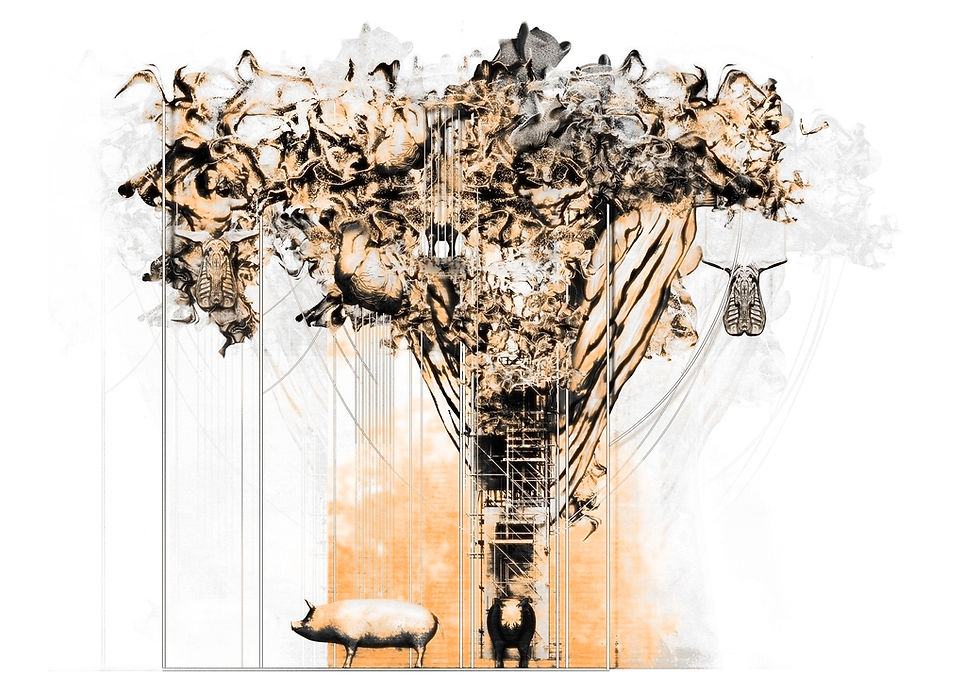Disease and efficiency
- Daniel James Wilkinson
- Jan 14, 2016
- 3 min read
Architectural Researcher and Tutor at The University of Hong Kong presents a contemporary Baroque that engages with unknown truths in ways which current architectural styles cannot.
“Beyond our immediate ends, man’s activity in fact pursues the useless and infinite fulfillment of the universe” - Georges Bataille.
We live in an occulted world, which is seemingly indifferent to the human economies, linguistic divisions, and expectations which we continue to place upon it. Disaster after pandemic, and then disease after disaster, the world is ultimately inconceivable, constantly resisting the comprehending tools of both socio-economic and scientific research. In short, we exist as part of an obscured condition. The consequence of this creeping hidden character of our planet - nature - has been a constant attempt to mould and tame our environment, through both description and manipulation, across almost all disciplines of human activity. As a result of the misguided Promethean ambitions triggered by the Enlightenment, our current age is governed by a fetishisation of efficiency and sustainability.

Believing we have no restraining limits, despite a well-documented history of being usurped at regular turns, we are free to orient ourselves towards the future, and shape it, according to our own expectations. Prometheanism positions human needs and concerns as the driving force to deliver us to a version of the future which we have defined in advance. With this approach, as a result of its undoubted belief in the consequences of human innovation and determination, environmental issues are reduced to little more than an inconvenience to be sidestepped; nature becomes a resource for our own ends. At an architectural level, the fetishisation of sustainability has resulted in a stylistically passive, or better yet, reasonable architecture, which generally achieves its credentials with off-the-shelf clip-on ‘green’ products. Through adhering to industry guidelines, our version of the future can be saved. But does this confidence in a market approved idea of the ecological not represent a continued failure to understand that our ‘true’ context exists beyond the narratives we maintain to veil unknown truths? An unknowable background exists indifferently to our actions, and is seemingly always willing to disregard our expectations. Our social context, congested by rot and wealth, is seemingly at odds with itself.

What if an architectural style, say, a contemporary Baroque, could begin to stylistically engross itself with the hiddenness of our unknown natural condition? Although commonly disregarded as the whims of exuberance, the Baroque, in its initial diagnosis by Heinrich Wölfflin, was outlined as an oppositional style which willingly corrupted the misgivings of the traits it opposed. Wölfflin’s work led to Spanish philosopher Eugenio d’Ors (1881 – 1954) conceptualising the Baroque as both a cyclical, and corrupting, political force. Eugenio believed he could identify 22 previous Baroques - including a Macedonian, a Nordic, and a Buddhist - where in all cases, a self-maintaining social order had been usurped both politically and stylistically. Importantly, d’Ors expected a 23rd irruption against the ‘reasonable’ expectations of the modern age. The Baroque, for d’Ors, is an event of force unified through the “canonisation of movement, as opposed to the parallel tendency towards stasis that characterises the rational”, d’Ors referred to the objective situation of any socio-political order, and its norms, by stating that “human reason is always looking through bars”.1 Through engaging with tectonic obscuration and partial figurations, rather than celebrating immediate legibility and the demands of reason, could a style begin to engage with the very idea that the more we look, the less we know? And as such, could an architecture which is beginning to drown in its own fixations, begin to illustrate our actual condition beyond the bars of reason?

Twitter: @dansapien AHRC funded PhD candidate at the Bartlett, UCL and Architectural Researcher and Tutor at The University of Hong Kong.
1. Zamora L and Kaup M. (eds.) Baroque New Worlds. Durham: Duke University Press, 2010.



Comments